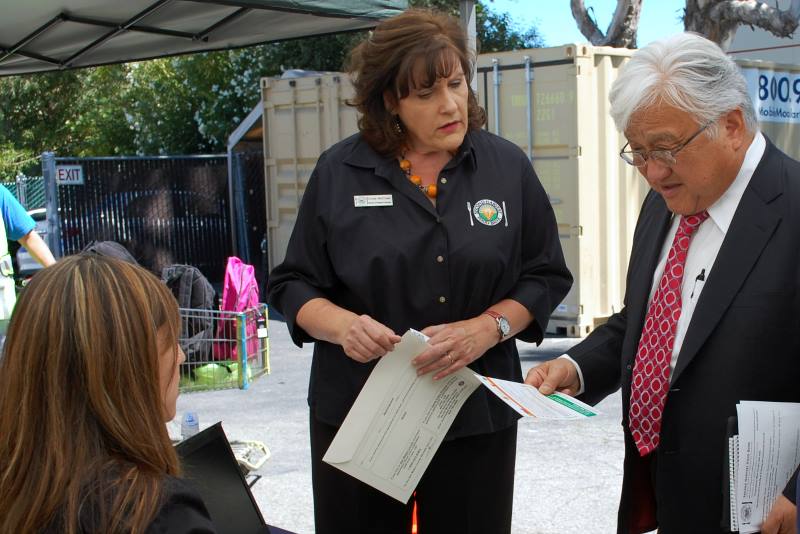Special post by Caitlin Kerk, Second Harvest supporter and consultant
I knew of Cindy McCown long before I ever worked at Second Harvest. She has been the go-to person when it comes to hunger and food access in Silicon Valley for more than three decades. After 34 years at the Food Bank, Cindy is retiring. It would not be hyperbole to say she has left an indelible mark on local hunger and food-access policy through her dedication and leadership.
Cindy’s interest in hunger was sparked by an internship she did in the early 1980s during graduate school. She was studying nutrition at California Polytechnic State University in San Luis Obispo. For nine months she taught nutrition to the children of migrant workers in the agricultural town of Oceana. Most of the families were very poor, and Cindy saw firsthand how hard it is to eat a healthy diet when you can’t afford nutritious food.
“It became very clear that nutritious food is critical for the healthy development of kids,” she said. “I also got a better understanding of systems and how they are impacted by public policy. It was a good early lesson for my career. I learned that change can take time, but you have to be persistent.”
When a community nutritionist job opened up at Second Harvest in 1984, she jumped at the opportunity. At that time, the Food Bank was located in an old bottling plant and had an annual budget of less than $1 million. Today, Second Harvest is a $42-million organization with three large facilities, including a dedicated produce distribution center.
Cindy rose through the ranks at Second Harvest, heading its programs and services for many years. In that time, she helped to transform how the Food Bank operates, strengthen the local hunger-safety net, and secure key public policies that have increased food access for everyone.
Early Pioneer
Food-banking was a relatively new concept when Cindy joined Second Harvest, and she helped establish it as an early pioneer. She led efforts to create a more organized way to distribute food, devising a zip-coding system to ensure that anyone who needs a healthy meal can get one right in their own neighborhood. Today Second Harvest distributes food with the help of 300 nonprofit partners at more than 900 sites in nearly every zip code. She was also responsible for instituting a number of critical programs and services, including Second Harvest’s multilingual Food Connection hotline that connects callers to food.
Cindy understood that to effectively fight local hunger, Second Harvest had to be more than just a food provider. She is responsible for many of the key partnerships that make the Food Bank’s work possible today, including with county government, schools and other nonprofit organizations. Her efforts out in the community helped to establish Second Harvest as the local leader on ending hunger.
After the Loma Prieta earthquake in 1989, she helped to establish the Collaborating Agencies Disaster Relief Effort (CADRE), providing an effective way for nonprofit service providers to work together after a disaster. The Food Bank continues to be part of the CADRE leadership team today.
In 1997, she helped to create the Safety Net Project with the Santa Clara County Social Services Agency and other nonprofits to address the impacts of welfare reform. The Safety Net Committee was formed so service providers could collaborate with each other and the county to better meet the basic needs of area residents, and Cindy continues to co-chair the committee.
In 2010, she led efforts with the Santa Clara County Social Services Agency to secure millions of dollars through the American Recovery and Reinvestment Act to feed those hurt by the recession. Thanks to her leadership, Santa Clara was the first county in California – and possibly even the nation – to provide “stimulus food boxes” to those in need. San Mateo County soon followed.
Public Policy Wins
She developed the first public policy agenda at Second Harvest, and throughout her time at the Food Bank, she worked with legislators and public officials to educate them about the need for policies that increase food access. Her efforts resulted in a number of key wins over the years, including eliminating the requirement that CalFresh (food stamps) applicants be fingerprinted. Second Harvest has been honored with Feeding America’s Advocacy Hall of Fame for the last four years due to her efforts.
In 2015, she was named Vice President of Community Engagement and Policy at Second Harvest, a position created specifically for her to capitalize on her proven ability to bring together people and resources – both private and public – to fight local hunger. In that role, she was instrumental in creating the Children’s Nutrition Coalition, which includes more than a dozen school districts as well as libraries, youth groups, social service agencies and other organizations that have a vested interest in ensuring kids get nutritious food, particularly during the summer when families lose access to school meals. She launched Second Harvest’s school breakfast initiative to encourage schools in high-need areas to provide breakfast to students, resulting in 311,000 additional meals served last year.
Even with all of these accomplishments (and others not listed here), when I asked Cindy to name her biggest one, she said it was the relationships she has built over the years. For her, it’s always been about the people. Thanks to Cindy’s work, many more people – kids, families, college students and seniors – are getting the nutritious food they need to fully engage in their lives. That’s quite an accomplishment!
